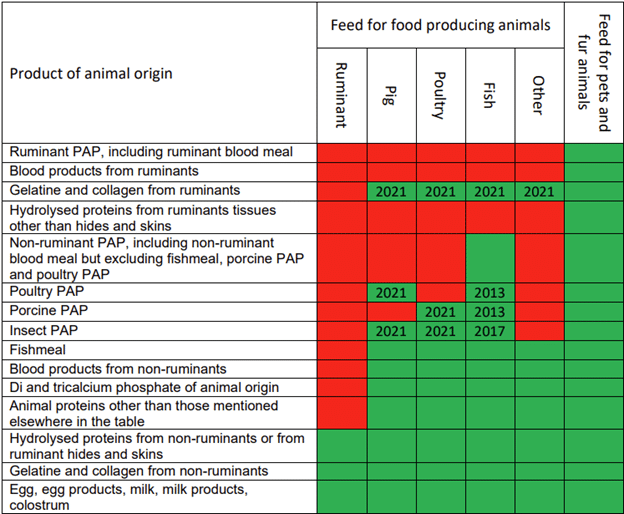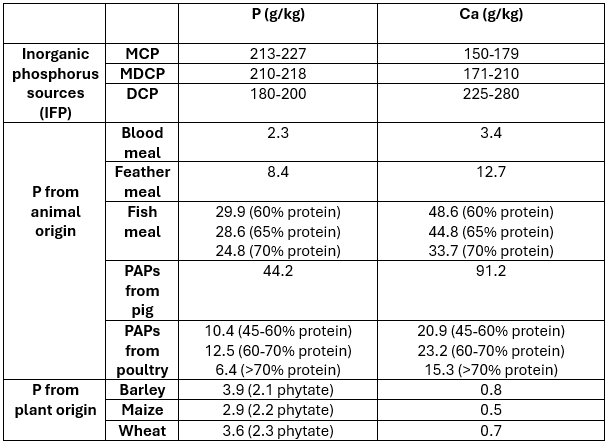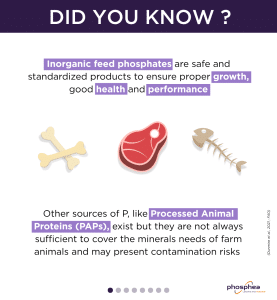Phosphorus (P) in animal feed originates from 3 different sources: organic sources of animal origin, organic sources of plant origin and inorganic sources known as Inorganic Feed Phosphates (IFP).
This article presents the key characteristics of each phosphorus source and provides a comparative analysis.
Abstract
The phosphorus (P) found in animal feed can come either from organic or inorganic sources. Animal-derived phosphorus sources include Meat and Bone Meal (MBM), Meat Meal (MM) and other Animal Derived Proteins (ADP) like blood meal, feather meal, fish meal and poultry meal. However, the use of these Processed Animal Proteins (PAPs) on the market is strictly regulated due to their association with Bovine Spongiform Encephalopathy (BSE). Phosphorus (P) in feed ingredients from plant origin is another organic source. This P is mainly stored under the form of phytic acid which is poorly digestible by monogastric animals. The addition of phytase is thus necessary to make the plant phosphorus available for animals. But phytases are generally prohibited in organic farming and sensitive to heat and acid conditions which can lower their efficiency. Finally, Inorganic Feed Phosphates (IFP) are safe, standardized inorganic sources of P with high digestibility enabling more efficient P utilization by the animals and reduced environmental excretion of P. They are appreciated for their consistent chemical composition which facilitates formulation and manufacturing process while supporting both performance and compliance with regulatory standards.
I. Animals: an Organic P source
1. Animal-derived meals: MBM (Meat and Bone Meal), MM (Meat Meal) and other protein sources
- What is MBM?
Meat and Bone Meal (MBM) is defined as a dry, ground, rendered product containing both bone and animal tissues, excluding hair, hooves, hide and horn (Roginski et al., 2002). The regulatory definition in the United States further specifies that this must concern mammalian tissues, and that blood, manure, stomach and rumen contents are excluded.
- MBM vs MM: a matter of P and Ca contents
In a large majority of countries, MBM is permitted in livestock feed (excluding ruminant feed) and provides mainly proteins, amino acids, energy, phosphorus (P) and calcium (Ca). In the American regulation, MBM must contain at least 4% P, the Ca content must not exceed 2.2 times the actual P level, and ingredients with lower bone content, and thus lower P content, are defined as Meat Meal (MM) (Devine and Dikeman, 2014).
The fourth edition of Fish Nutrition published in 2021 notes that the primary difference between MBM and MM lies in their P content, which is less than 4.4% in MM. In addition, Ca content of MBM ranges from 8.8% to 12%, while MM generally contains about 3% less Ca. Finally, both ingredients have relatively high ash contents, about 27% and 31% for MM and MBM, respectively.
- Nutritional profile and variability of Animal-Derived Proteins (ADP)
Both MBM and MM generally have protein levels meeting or exceeding 50% of their dry weight (Devine and Dikeman, 2014) but it is also referred in many publications that MBM generally have lower protein (< 55%) and higher fat and ash levels than MM (Lall and Dumas, 2022 ; McLean, 2023). Standards vary among countries and species and are not always clearly established. Nevertheless, manufacturers should declare minimum guaranteed levels for crude protein, calcium and fat.
Blood meal, feather meal, fish meal and poultry meal are other types of animal-derived products from processing animal tissues inedible for human. With MBM, they are considered as the major Animal Derived Proteins (ADP) (Devine and Dikeman, 2014).
2. European regulation about Processed Animal Proteins (PAPs)
- What are PAPs?
Processed Animal Proteins (PAPs) are defined as animal proteins derived exclusively from low risk material from healthy animals declared fit for human consumption following an inspection before slaughter. However, although the materials used to produce PAPs — which may come from any part of these healthy animals — are safe for human consumption, they are ultimately not used in the human food chain, mainly due to low or absent consumer demand for such products. Protein derived from high-risk material, such as cadavers and specified risk material, are strictly excluded from use in PAPs (Regulation (EC) No 999/2001- Official Journal of the European Union, 2021).
- Bovine Spongiform Encephalopathy (BSE) crisis and the evolution of feed regulations
BSE, also referred to as mad cow disease, is a chronic degenerative disease caused by a pathogenic prion (abnormal protein), affecting the central nervous system and which spread mainly in European cattle in the 1980s and 1990s. BSE is referred to as Variant Creutzfeldt-Jakob disease (vCJD) in humans. The illness, which was first discovered in 1986, results in irregular body posture, incoordination, difficulty in standing, weight loss, and temperamental changes in affected cows.
The only known risk factor for BSE development being feeding livestock MBM obtained from BSE-infected livestock contaminated with BSE prions (Lestari, 2025), the European Union adopted the TSE Regulation in 2001, banning all processed animal proteins (PAP) in feed for all farmed animals (Regulation (EC) No 2021/1372 – Official Journal of the European Union, 2001).
As the issues behind the feed ban for non-ruminants were resolved – including BSE control, species separation and reliable testing – , a 2021 EU regulation reauthorized, as showed in Table 1:
- PAPs derived from pigs and insects for use in poultry feed;
- PAPs derived from poultry and insect for use in pig feed;
- Gelatine and collagen of ruminant origin in the feed of non-ruminant farmed animals.

Table 1: Legal restrictions to the use of material of animal origin in feed, taking into account the modifications introduced by Regulation (EU) 2021/1372 in 2021 (FEFAC)
With the exception of milk and – since 2021 – of gelatine and collagen, feeding any farmed animal with protein derived from ruminant animals remains completely prohibited. Simultaneously, feeding ruminants with any animal-derived protein remains also completely prohibited, with a few limited exceptions. Furthermore, the prohibition of intra-species recycling (the so-called cannibalism) is strictly enforced in the European Union (Regulation (EC) No 2021/1372 – Official Journal of the European Union, 2001).
European regulations on PAPs, which are among the strictest in the world, are followed by many other countries, especially those that trade these products (e.g. Brazil, Canada, China, Indonesia). However, enforcement varies depending on local contexts, control capacities and health priorities.
II. Plants, another organic source of P
Phosphorus (P) in feed ingredients from plant origin are mainly stored under the form of phytic acid (called phytate in its salt form). This molecule cannot be readily digested by monogastric animals like poultry and pigs, as they lack the appropriate enzyme activity in their digestive tract. Pig and poultry are able to digest only about 30% of the P in feedstuffs of plant origin. For instance, they digest 17% of sunflower meal P, 20-24% of maize and soybean meal P and 50-55% of wheat and barley P. The remaining percentages are therefore eliminated in the excreta without being digested.
Phytases allow the release of P from phytate, so it becomes available for digestion. Monogastric species are not able to produce this enzyme by their own. Furthermore, the phytase naturally present in seeds does not release enough P from raw materials and is partly destroyed by food manufacturing processes. Microbial phytase is thus commonly incorporated during feed manufacturing, under the form of powder, granulated coated or liquid form, to be chosen according to the temperature during the production process. This addition in animal’s diet allows an improved digestibility and assimilation of P from raw plant materials.
The Table 2 below shows the high variation of 3 phosphorus-related parameters (total P, phytate-P and phytase activity) from a plant feedstuff to another (RMT Élevage et Environnement, 2019).
| Feedstuffs | Total P (%) | Phytase-P (%) | Phytase activity |
|---|---|---|---|
| Maize | 0.28 | 0.19 | 15 |
| Wheat | 0.33 | 0.22 | 1193 |
| Barley | 0.37 | 0.22 | 1688 |
| Triticale | 582 | 0.37 | 0.25 |
| Rye | 0.36 | 0.22 | 5130 |
| Sorghum | 0.27 | 0.19 | 24 |
| Wheat bran | 1.16 | 0.97 | 2957 |
| Rice bran | 1.71 | 1.1 | 122 |
| Soybean meal | 0.61 | 0.32 | 8 |
| Peanut meal | 0.68 | 0.32 | 3 |
| Rapeseed meal | 1.12 | 0.4 | 16 |
| Sunflower meal | 1 | 0.44 | 62 |
| Peas | 0.38 | 0.17 | 116 |
Table 2: Total phosphorus, phytate-phosphorus and phytase activity in selected plant-feedstuffs (Fefana, 2002)
The increase of plant P digestibility permitted by phytase inclusion in feed also varies in different species or sub-species (Table 3).
| (Sub-)species | Plant P dig increase permitted by phytase inclusion |
|---|---|
| Post-weaning piglets | 20-30% |
| Grower pigs Finisher pigs Gestating and lactating sows | 15-20% |
| Broilers, Layers, Turkeys | 20-30% |
Table 3: Plant phosphorus digestibility increase permitted by phytase inclusion in feed of various species or sub-species (European Commission, 2017)
Nevertheless, the use of phytate as phosphorus source has many constraints. Indeed, since phytases are commonly produced using genetically modified microorganisms (GMOs), its use is generally prohibited in organic farming (European Commission, 2017). Moreover, phytases, like many enzymes, are susceptible to thermal degradation during feed processing. For example, the pelleting process, which can reach temperatures up to 95 °C, can significantly reduce phytase activity (Garrett et al., 2004 ; Tu et al., 2024). Phytase performance can also be sensitive to highly acidic conditions of monogastric digestive tract, which are not ideal for enzymes with higher pH optima (Garrett et al., 2004). Phytase activity may also be compromised due to interactions with certain feed ingredients, such as the formation of insoluble phytate-mineral complexes (Shanmugan, 2018).
The “Use of highly digestible inorganic phosphates to partially replace traditional sources of phosphorus in the diet” is mentioned in the Official Journal of the European Union as one of the Best Available Techniques (BAT) to reduce total P excretion while meeting the nutritional needs of animals (European Commission, 2017).
III. Inorganic Feed Phosphates (IFP)
Inorganic Feed Phosphates (IFP) are considered as highly digestible source of phosphorus (P)They are frequently used to replace conventional sources of P in the feed and increase P digestibility. They may be available under the form of powder, micro-granules or granules.
Contrary to plant-phosphorus, IFP’s chemical composition and digestible P content are predictable, partly because IFP are not susceptible to process conditions such as heat and moisture. It ensures consistent composition and regulations conformity, allowing precision nutrition.
A direct consequence of the high P digestibility is the reduction of P excretion in the environment. Table 4 provides an example of reduced P excretion achieved through the use of Monocalcium phosphates (MCP), a highly digestible feed phosphates, compared to Defluorinated Feed Phosphates (DFP), a low digestible feed phosphate. The shift from low to high digestible P is particularly relevant in regions with high animal density, where environmental challenges tend to be more severe.

Table 4: Calculated reduction of phosphorus excretion based on digestibility, for the poultry sector
The use of highly digestible feed phosphates can be implemented easily. The selection of highly digestible IFP is guided by their digestible P content and their economic performance compared to other types of feed phosphate (European Commission, 2017).
The most common types of IFP are Monocalcium Phosphate (MCP), Monodicalcium Phosphate (MDPC) and Dicalcium Phosphate (DCP). These phosphates are primarily distinguished by their P and Ca contents: MCP has the highest P content and lowest Ca content while DCP has the highest Ca content and lowest P content. Ca/P ratio is thus a good tool to classify these 3 IFP types (Figure 1). Among the three, MCP is considered the highest quality phosphate thanks to its superior digestibility, which allows better P absorption by animals and contributes to reduced P excretion into the environment (Bikker et al., 2016 ; Gómez, 2023).

Figure 1 : The Ca/P ratio, a reliable tool to classify common IFP
The Table 5 below compares P and Ca contents in various P sources: inorganic, animal and plant-origin. The figures show that inorganic phosphorus sources (IFP) consistently provide much higher levels of P and Ca compared to organic sources.

Table 5: P and Ca contents in various phosphorus sources: inorganic, animal and plant-origin (Phosphea, INRAe tables, 2025)
Conclusion : Comparison between phosphorus from animal, plant and inorganic origin
As previously noted, P sources derived from animals and plants often contain low and variable levels of minerals. This may not adequately meet the nutritional requirements of farm animals. The high P and Ca digestibility of Inorganic Feed Phosphates (IFP) – such as MCP, MDCP and DCP – enable both more precise and efficient usage, and a reduced environmental footprint. Furthermore, contrary to P from plant origin, IFP are always useable in organic production and they don’t need phytase addition in the production process. Conversely, the use of plant-based P may require the use of IFP to limit the formation of insoluble phytate-mineral complexes. This is precisely the role of the patented product HumIPHORA: it limits the recomplexation ofCa) with phytic P in the gut, thereby enhancing total P absorption. As a result, it both reduces the need for IFP supplementation and minimizes P excretion in the litter.
IFP are also valued for their consistent composition, which simplifies formulation and manufacturing processes while supporting both performance and compliance with regulatory standards. To conclude, beyond being standardized products, IFP offer key advantage of feed and food safety thanks to their inorganic (inert) origin, especially when compared to phosphates of animal origin.
View our Did You Know about Animal vs inorganic P sources on our LinkedIn page:
https://www.linkedin.com/posts/phosphea_inorganic-feed-phosphates-activity-7344253544163631104-KJdM

Bibliographical sources
Bikker et al., Precaecal phosphorus digestibility of inorganic phosphate sources in male broilers, British Poultry Science, 57:6, 810-817, 2016 https://doi.org/10.1080/00071668.2016.1222604
Devine and Dikeman, Encyclopedia of Meat Science, 2014 https://shop.elsevier.com/books/encyclopedia-of-meat-sciences/devine/978-0-12-384731-7
European Commission, Autorisation to use certain proteins of animal origin to feed non-ruminant farmed animals, 2021 https://eur-lex.europa.eu/eli/reg/2021/1372/oj/eng
European Commission, Control of TSEs (including BSE and scrapie) https://eur-lex.europa.eu/eli/reg/2001/999/oj
European Commission, JRC Science for Policy Report, Best Available Techniques (BAT) Reference Document for the Intensive Rearing of Poultry or Pigs, 2017 https://publications.jrc.ec.europa.eu/repository/handle/JRC107189
FEFAC, Factsheet on Processed Animal Protein and their conditions of use in Animal Feed , 2021 https://fefac.eu/wp-content/uploads/2021/08/21_MEMO_15_Feedban.pdf
Garrett et al., Enhancing the thermal tolerance and gastric performance of a microbial phytase for use as a phosphate-mobilizing monogastric-feed supplement, ASM Journals, 2004. https://doi.org/10.1128/AEM.70.5.3041-3046.2004
Gómez, The Quality of Feed Phosphate, Engormix, 2023 https://en.engormix.com/poultry-industry/minerals-poultry-nutrition/the-quality-feed-phosphate_a52184/
INRAe Feed tables https://feedtables.com/content/feeds?field_feed_category_target_id=30&sort_by=title_field_value&sort_order=ASC https://feedtables.com/content/feeds
Lall, Fish nutrition, 4th edition, 2021 https://www.sciencedirect.com/book/9780128195871/fish-nutrition
Lall and Dumas, Feed and Feeding Practices in Aquaculture, 2022 https://www.sciencedirect.com/book/9780128215982/feed-and-feeding-practices-in-aquaculture#book-info
Lestari, Bovine Spongiform Encephalopathy: A review of current knowledge and challenges, 2024 https://www.bibliomed.org/mnsfulltext/100/100-1728570435.pdf
McLean, Feed Ingredients for Sustainable Aquaculture, in Sustainable Food Science – A comprehensive approach, 2023, pages 392-423, 2023 https://www.sciencedirect.com/referencework/9780128241660/sustainable-food-science-a-comprehensive-approach
RMT Élevage et Environnement, Guide des bonnes pratiques environnementales d’élevage. Fiche V4 : Utilisation de phytases, de phosphates alimentaires hautement digestibles et autres additifs, 2019 https://www.rmtelevagesenvironnement.org/docs/fiches/gbpee/volaille/v-fiche-4.pdf
Roginski et al., Encyclopedia of Dairy Science, 2002 https://shop.elsevier.com/books/encyclopedia-of-dairy-sciences/roginski/978-0-08-091793-1
Shanmugan, Characteristics of phytase enzyme and its role in animal nutrition., International journal of current microbiology and applied science, Volume 7 Number 03, 2018. https://doi.org/10.20546/ijcmas.2018.703.120
Tu et al., 2024, Achieving thermostability of a phytase with resistance up to 100°C, Journal of biological chemistry, Volume 300, Issue 12, 2024. https://www.sciencedirect.com/science/article/pii/S0021925824024943



